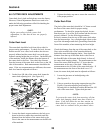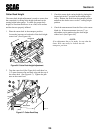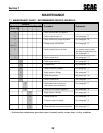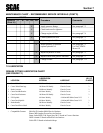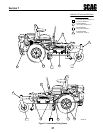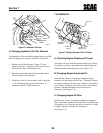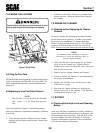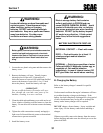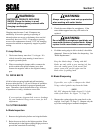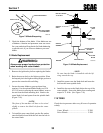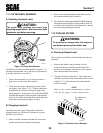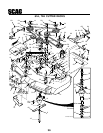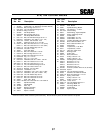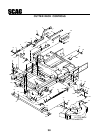
Section 7
31
Electric storage battery fluid contains
sulfuric acid which is POISON and can
cause SEVERE CHEMICAL BURNS. Avoid
contact of fluid with eyes, skin, or clothing.
Use proper protective gear when handling
batteries. DO NOT tip any battery beyond
45° angle in any direction. If fluid contact
does occur, follow first aid suggestions
below.
BATTERY ELECTROLYTE FIRST AID
EXTERNAL CONTACT — Flush with water.
EYES — Flush with water for at least 15
minutes and get medical attention
immediately.
INTERNAL — Drink large quantities of water.
Follow with Milk Of Magnesia, beaten egg, or
vegetable oil. Get medical attention
immediately. In case of internal contact, DO
NOT give fluids that would induce vomiting.
WARNING:
Lead-acid batteries produce flammable and
explosive gases. To avoid personal injury
when checking, testing or charging
batteries, DO NOT use smoking materials
near batteries. Keep arcs, sparks and flames
away from batteries. Provide proper
ventilation and wear safety glasses.
WARNING:
1. Loosen the two plastic wing nuts and then remove the
battery cover.
2. Remove the battery cell caps. Visually inspect
electrolyte level in the cells. If electrolyte is
below the bottom of vent well, fill with clean distilled
water to the bottom of vent wells (1/4 to 1/2 inch
above the plates). Install the battery cell caps.
-IMPORTANT-
Do not overfill the battery. Electrolyte will over-
flow through the vent tube onto parts of the
machine, resulting in severe corrosion.
3. Clean the cable ends and battery posts with steel wool.
Use a solution of baking soda and water to clean the
battery. Do not allow the solution to enter the battery
cells.
4. Tighten the cable connections securely and apply a
light coat of silicone dielectric grease to the terminal
connections to prevent corrosion.
5. Install the battery cover.
B. Charging the Battery
Refer to the battery chargers manual for specific
instructions.
Under normal conditions the engines alternator will have
no problem keeping a charge on the battery. If the
battery has been completely discharged for a long period
of time, the alternator may not be able to recharge the
battery, and a battery charger will be required.
DO NOT charge a frozen battery. It may explode and
cause injury. Let the battery warm before attaching a
charger.
Whenever possible, remove the battery from the mower
before charging and make sure the electrolyte covers the
plates in all cells.
WARNING:
Battery posts, terminals, and related accessories
contain lead and lead compounds, chemicals
known to the State of California to cause cancer
and reproductive harm. Wash hands after han-
dling.



